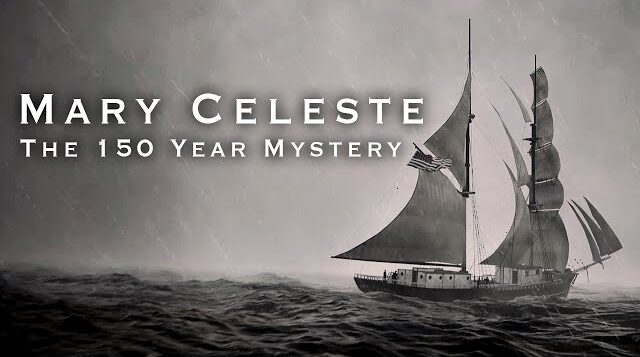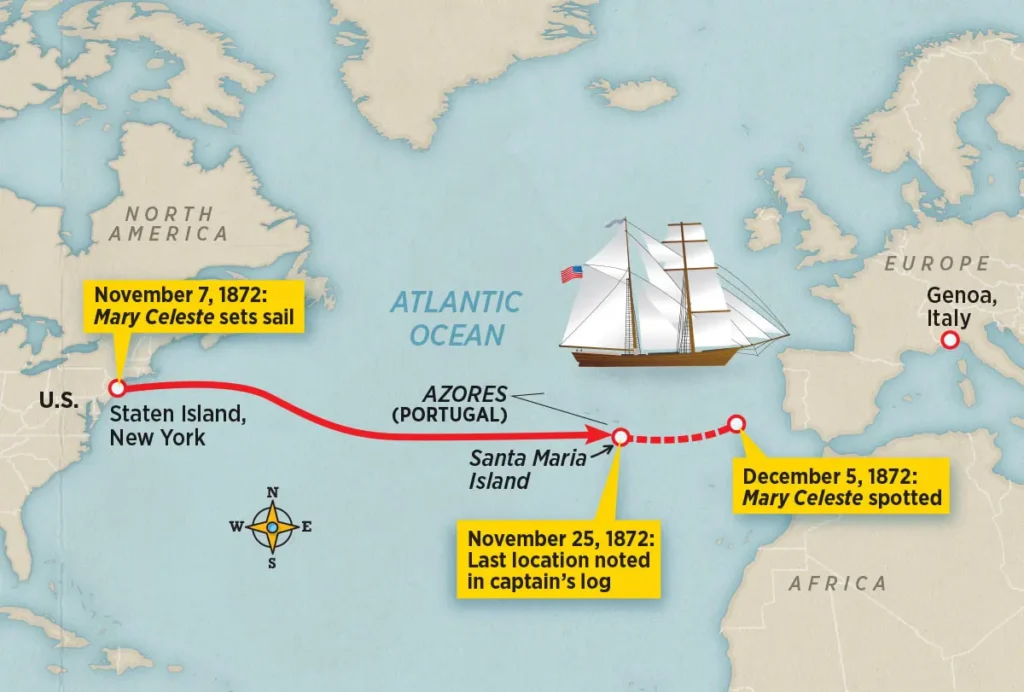“Lost at Sea: The Unsolved Mystery of the Mary Celeste”


“The Mary Celeste has became one of the best-known maritime mysteries, referred to as a “ghost ship” in folksongs and folklore. An American brigantine that was found adrift and deserted in the Atlantic Ocean in 1872, with not a single soul nor any trace of what motivated its crew to vanish into thin air. Despite the mysteries solved and unnamed, perhaps Riley’s murder will remain one of those unanswered questions. This is the comprehensive account of Mary Celeste story, combining proven facts with theories and power mary celeste left behind.”
Mary Celeste Origins
Built in 1861, the ship was originally called Amazon and created in Nova Scotia, Canada. Launched as a brigantine—a two-masted sailing vessel—the Amazon had an inauspicious early life, beset by accidents and bad luck. Among these were the first captain of her exploding suddenly dead in his boat during a hunt and various other mishaps which cursed as voyages. The ship changed hands several times, earning a legacy as ‘an unlucky vessel’ before being sold to an American owner in 1868 and re-named the Mary Celeste.
The ship underwent extensive repairs and overhauls, then was recommissioned. Both its new owner, James H. Winchester and the man he hired to captain it— Benjamin Spooner Briggs were known in maritime circles as solid guys who commanded immense respect. Briggs, an experienced seaman and Episcopalian Christian, was named captain of the Mary Celeste in 1872. The ship was at the time readying for a transatlantic trip, from New York City to Genoa, Italy.
The Voyage and Disappearance
The Mary Celeste sailed from New York Harbor on November 7, 1872 loaded with denatured alcohol in casks — to be used as a drinking fortifier for industrial use (it effectively acted like meths or other blue-methylated spirits). Captain Briggs, his wife Sarah and their 2 year old daughter Sophia as well as a crew of seven experienced seamen were aboard. They were among 10 people onboard. The weather was calm, and it looked as though it would be a basic sailing.
But almost a month later, on the 4th of December in that year, British brigantine Dei Gratia found this ship adrift off Azores Islands (around 400 miles from Portugal). Dei Gratia — long skipped by David Morehouse, the Dei Gratias destiny from New York was eight days in front of that of the Mary Celeste synchronized swimming on a similar course. The approaching crew of the Dei Gratia saw that she was moving in an irregular manner without a human at her helm.
When the crew of Dei Gratia boarded the Mary Celeste she was in apparent good order, excepting that her sails were badly set and none of them knew to where or why but she had no one on board. (Captain Briggs [and] his wife daughter & all hands having disappeared just half an hour after they left Gibraltar!) Although there were no signs of foul play, the ship was still intact but taking on water: a reported 3.5 feet in the hold according to investigators. The crew had evidently made a run for it, as the lifeboat was gone. Most of the alcohol cargo was recovered, with only nine empty barrels being located. This food and the water was orderedly lactic to prompt a few months — here were personal property of captain notwithstanding group, law gave nothing thought around this having been disturbed.

Theories and Speculation
The Mary Celeste mystery ignited all manner of theories, some conceivable, others verging on the fantastical. Over the years, such speculations have vied to throw light on why a skilled crew might flee from ship that never sank Following are some of the most popular theories:
- Piracy or Foul Play
Initially, the ship being subject to piracy was one of the key theories explored. Searches failed to turn up any signs of violence, and the ship’s expensive cargo as well as personal belongings were not taken. Pirates would not have left the ship and its cargo unattended.
- Mutiny
Mutiny was another theory, revealing that the crew possibly mutinied against Captain Briggs and escaped in a lifeboat. But there was no proof that a violent uprising had occurred, and Captain Briggs was known as an even-tempered man for whom the Indians felt much respect. Besides, since the crewmen in question were experienced and had been with them a long time together — a circumstance hardly suitable for instigating mutiny.
- Alcohol Explosion
The denatured alcohol cargo fueled speculation that vapors from the alcohol may have accumulated in the hold and either exploded or posed a risk of ignition. There is a possibility that Captain Briggs feared the cargo might explode and so he ordered the crew to evacuate from his ship at least temporarily. They could have been in the lifeboat themselves and never made it back. It explains the missing lifeboat and why the crew fled the ship.
- Waterspout or Seaquake
Others speculate that the ship may have flooded due to a natural disaster such as waterspout (tornado at sea) or an underwater earthquake(Seaquake), and placed the crew in panic mode where they might leave it. And while there was some water in the hold of the Mary Celeste, other parts of the ship were fully functioning suggesting that it could have still been sailed. This theory doesn’t explain why a relatively experienced crew didn’t come back.
- Intentional Abandonment by Military Miscalculation
Maybe Captain Briggs found a leak–a ruptured pump or just an erroneous assessment of the water in his hold–and declared that they were going down. He might have decided to take a lifeboat off the ship, in that fateful moment. And had they been blown further out, or otherwise run into difficulties at sea while becalmed, might not have made it. - Paranormal Explanations
Naturally other, more supernatural explanations have been suggested (ghostly hauntings, sea monsters or UFO abductions). While these theories have not been given much credence among experts, they remain a part of the Mary Celeste legend in pop culture lore as well.

Background: The Investigation and Its Aftermath
After being found, the Mary Celeste was towed by The Dei Gratia into Gibraltar so that a proper salvage hearing could determine how much of an award would be owed to those who brought in this abandoned vessel. Attorney General Frederick Solly-Flood, who distrusted the Dei Gratia crew’s testimony, took charge of an exhaustive inquiry organised by the Gibraltar Vice Admiralty Court.
Solly-Flood did raise the spectre of some kind of foul play too, wondering if it was all a somewhat conspiratorially minded plot by the crew on board Dei Gratia to make money from salvage with Mary Celeste. Nevertheless, as there was no proof of foul play to suggest the members in Dei Gratia had any hand in this matter, they received a part payment of salvage that had been cut down; some mistrust remained but nobody ever did anything amiss.
Retirement and Last Voyage
The Mary Celeste carried on under different owners but was continually beset by financial problems. It passed through many hands but never shook off the cursed reputation. It was the victim of insurance scam via intentional grounding off Haiti by its final owner in 1885. The attempt did not succeed, and the ship sank to demise on the sea bottom.
Legacy and Cultural Impact
The mystery of the Mary Celeste has become one of the greatest seafaring legends ever. Its story has been the subject of numerous books, documentaries, films and other works. It is frequently invoked in the context of ghost ships, boats discovered derelict and abandoned at sea often with visible signs that their crew had vanished under suspicious circumstances; most maritime authorities felt no need to investigate.
The case has become subject to dark speculations as authors and storytellers have woven layers of mysteries around it. Fictional J. Habakuk Jephson’s Statement by Sir Arthur Conan Doyle (1884)In 1884, the Mary Celeste Mystery was given a new swerve when one of its characters got involved in a fictional story and this was through the pen work of Sherlock Holmes’ father — who authored it as “J. Habakuk Jephson’s Statement”. In doing so, he wove an appeal to the unknown and a twist of conspiracy into his tale that seized hold its audiences like few retellings had before — forever staining mainstream conceptions as to what happened in Whitechapel.
Although the modern experts of maritime history, despite their belief that St Andrews did get lost for reasons unknown to us at present. The most likely theory of the lot, but not without its problems, involves a build up of alcohol fumes leading to an abandonment seemingly only temporarily.
Modern Reinvestigations
But more than a century and half later, the case of Mary Celeste is still mentioned in dictionaries when ship captains are described as never losing their nerve – no doubt an old-fashioned sentiment. And also through the 21st-century fascination with unsolved mysteries regard…that this one persists to whisper both history and replicable experimentation…. “[H]oly & blessed Power that guides The Last Long Voyage”: the chronometer of Cook’s ship, with some missing instruments also perhaps taken by the crew to be used on their lifeboat. There was also a rope trailing from the stern of the lifeboat, leading investigators to believe “the crew might have kept tying on and then drifting until they were finally separated.”
There were no fewer than nine empty barrels in the hold, which suggests some of them could have been defective and leaking (alcohol is highly flammable) fumes. The hasty evacuation would be easier to accept if the personnel smelled something and interpreted it as an impending catastrophic explosion. Yet the absence of explosions, fire or other apparent immediate risks on the ship seems to challenge this narrative.
Its state, with some sails furled and others unfurled in very bad repair (probably emergency sail setting). There were no severe storms along the track of y2k38 during those days, but whatever was behind their disappearance could have been sudden and a surprise—like perhaps an unexpected rogue wave or waterspout.
Conclusion
The Mary Celeste still ranks as one of the most baffling maritime legends; a true ghost ship born wholly out of reality. For over a century its crew remained experienced, the ship maintained and it was found undisturbed with nobody in sight for any manning or explanation. Hundreds of theories, from scientific to supernatural proposals and despite all this we will never know what really happened with the crew members that embarked on Mary Celeste Such an enigma persists as a poetic reminder of the power and capriciousness by which we have been humbled upon even to this day.
If you liked it, you may also like our other blog.






